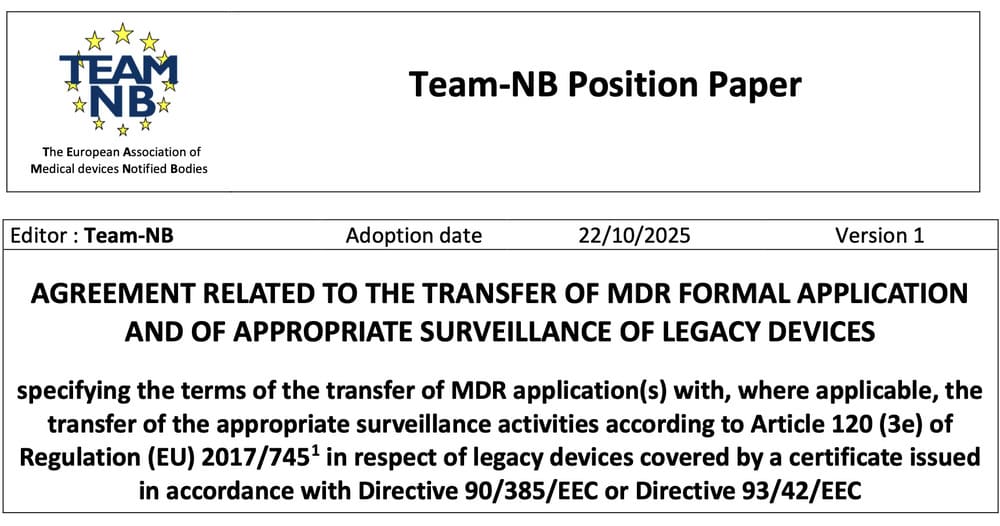
MDR: what does the transfer agreement published by Team-NB really change?
News
The pressure on manufacturers to change their notified body has never been greater. Between uncertainty about the continuity of the MDR formal application and the fear of losing the benefit of the transitional regime, many remained blocked.
The model agreement published by Team-NB and endorsed by NBCG-Med finally provides a clear framework for securing a NB transfer without regulatory disruption.
Why was an MDR transfer agreement essential?
Regulation 2023/607 reinforced the logic of the transitional regime. To benefit from it, a manufacturer must have :
submitted a formal application MDR on time ;
concluded an MDR agreement with its NB ;
not break this agreement before signing the next one.
In practice, changing NBs created a risk: a simple delay between the end of the outgoing agreement and the signing of the new one could cause Article 120 to lapse, making it impossible to market legacy devices.
The lack of harmonized practices between NBs added further uncertainty.
What exactly does the Team-NB model agreement contain?
The document provides a contractual framework aligned with the MDR, covering two essential elements:
the transfer of the MDR formal application ;
the transfer, where applicable, of appropriate monitoring of legacy devices.
It specifies the commitments of each party:
the manufacturer does not withdraw its application before the transfer date ;
the outgoing NB does not reject it simply because the customer has left;
the incoming NB takes over the regulatory situation on the agreed date, with the option of continuing the review.
How does this agreement ensure the continuity of the transitional regime?
The key point is simultaneity.
The agreement formalizes a seamless contractual transition, where :
the outgoing MDR agreement ends only at the exact moment when the new agreement takes effect;
the original MDR application is considered to be maintained;
the regulatory status at the date of transfer remains recognized.
This continuity is sufficient to satisfy the conditions of Article 120, even after the deadlines introduced by regulation 2023/607.
The major risk (losing the transitional regime by changing NB) is therefore greatly reduced.
Limits and points to watch out for
The document provides a structure, not an absolute guarantee.
It does not correct an already weakened MDR application.
Incoming NBs are free to reject incomplete, insufficient or manifestly non-compliant applications.
Appropriate monitoring of legacy devices can be transferred, but only if MDD/AIMDD certificates are valid and not suspended.
Case studies
Case 1: technical review in progress
A IIb manufacturer filed its MDR application in 2024. The outgoing NB has started the document review, but the deadlines are getting longer. The manufacturer wishes to migrate to a more available NB.
The Team-NB agreement allows for a clean transfer: the incoming NB recovers the status of the file on the transfer date and resumes the review without jeopardizing the transition.
Case 2: legacy devices with appropriate monitoring
A company has private label certificates valid until 2028. Annual surveillance is partly carried out by the outgoing NB.
The agreement allows this surveillance to be transferred to the new NB without loss of validity, provided that the certificates are in good regulatory condition.
Mini-FAQ
1. Is transfer possible if major NCs are open?
Yes, but the incoming NB may refuse to continue if the NCs call into question the overall conformity of the dossier.
2. Does the entire portfolio have to be transferred?
No, the transfer can be partial. The perimeter is defined in the document appendices.
3. Is MDD/AIMDD surveillance still transferable?
Only if the certificates are valid and not suspended.
4. Do I have to inform the authorities?
No, except in special cases (local decision). Each NB applies its own internal procedure.
5. Is the agreement compulsory?
No, but it has become the de facto standard for securing MDR transfers.
Conclusion
The model agreement published by Team-NB is not a regulatory change, but a much-needed clarification. It reduces a real legal risk for manufacturers wishing to change NBs in the midst of an MDR transition, while providing NBs with a common framework.
In a context where MDR strategies are evolving rapidly, a secure transfer has become essential.
CSDmed brings its expertise and a methodical approach to its customers, start-ups, manufacturers, importers and distributors of medical devices, thanks to a team of experts and specialized consultants, who will be able to handle your R&D file, your QMS, and your MDR technical file in their entirety.
🔗 Contact us and find out how we can help you.
Related resources
EUDAMED: upcoming obligations for medical device manufacturers
MDR technical documentation: Avoid common mistakes and follow best practices